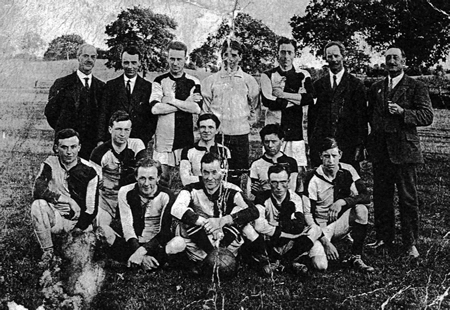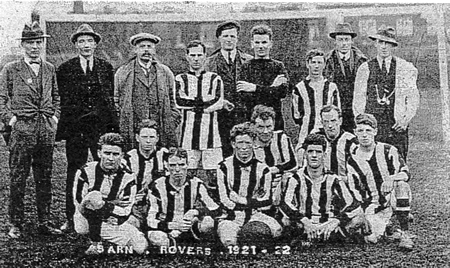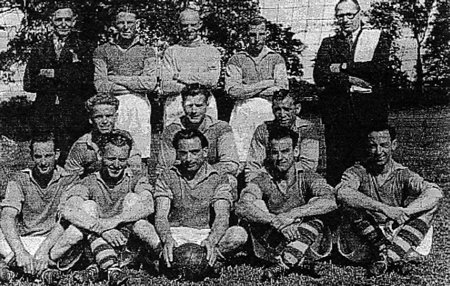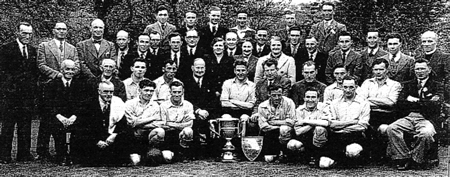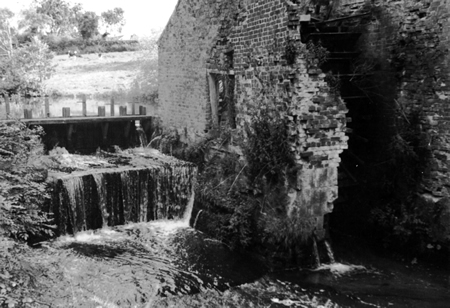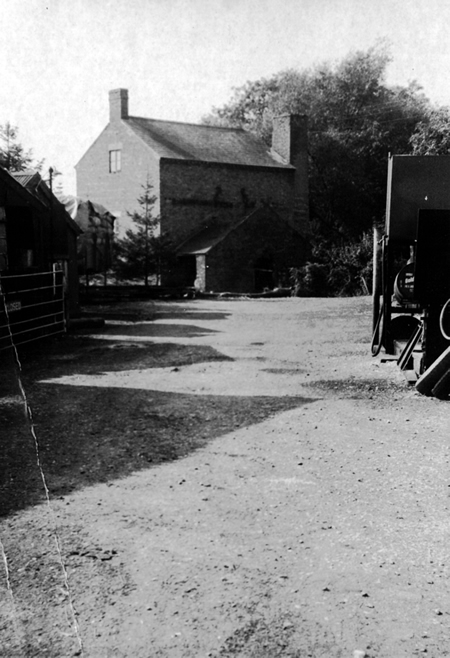The Sarn
The Sarn is on the border of Threapwood and although only a small area of premises straddling the English/Welsh Border has had a colourful history all of its own. The word Sarn means a ford or a causeway which is now a bridge - in fact there are two bridges, an older and a newer one side by side but which only appear as the newer one to the traveler. Where Well House is now, there used to be three cottages which were adjacent to the pub car park - the top one of these was a shop owned and run by Frank Jones who also provided a local delivery service of grocery goods.
The Well House is rightly named, as the well is still there down some steps to the side of the new house. From this well many of the local people drew their water for domestic use and you can understand why they did when you read the paragraph on the pollution of the brook in one of the following articles relative to the history of the Queens Head! The Sarn Wakes was an annual event up until the late 30's and used to be held on the small field adjacent to the bridge on the Threapwood/English side below Rock Cottage.
Threapwood on the English side and Tallarn Green on the Welsh side of the bridge(s) have always been very closely linked with The Sarn and have three features with much history shared between them. The three are The Queens Head, Sarn Rovers Football Club and Sarn Mill all of which are summarised in the articles below.
Sarn Bridge
The Sarn Bridge was built in 1627 and it is interesting to note that under the oldest arches the blocks of stone in each course are numbered, indicating that the masons John & David Smith dressed the stone to size, probably at the quarry, before bringing it to the site for erection.
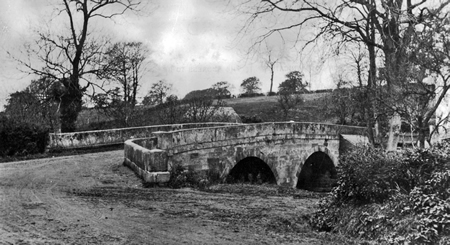 |
Sarn Bridge early photo. |
In 1819 another pair of arches was built to more than double the width of the bridge. The photograph below was taken during the restoration of Sarn Bridge in 1925 with admiring locals gathered to see progress.
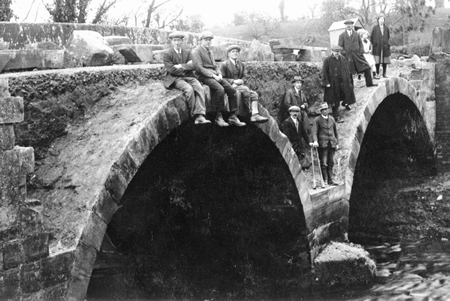 |
Sitting L to R on the bridge; Dave Walley, Tom Harper, Ted Mort. Standing with cap; Lloyd Gostage. First Man with overcoat; George Manford. Girls; Vera and Mona Fowles. |
Another bridge in Threapwood (not pictured) is that which carries the Malpas road over Flennens Brook. Built of stone in 1822, an inscription bears the initials of four gentlemen who presumably subscribed to the building of it. They were the Reverend Whitehall Davies of Broughton Hall, Sir R R Puleston of Emral Hall, the Reverend W W Drake of Malpas and the Reverend William Barnes of Threapwood.
A brief History of The Queens Head - Known Locally as The Sarn Pub by Dudley Realff
The Inn (as it was known) is situated on the Threapwood bank of the Wych Brook where the brook exits Sarn Mill. The Inn has had other names and has been at various times;
a) a meeting place for the North Shropshire Hunt
b) a place where inquests were held
c) an auction venue
d) a place where Sarn Rovers changed for home games
In 1813 a man called John Leadsom and his wife Jane had a daughter christened in Threapwood church and he was described as "an Innkeeper" at Sarn Bridge.
They had a son christened in the same year and in 1816 another son, followed by a daughter in 1819. By 1841 they had moved to Brook Farm Willington where John died soon after. In 1818 a man called Edward Maddox- a maltster- and his wife were living at Sarn Bridge and it is believed that they were living at the Inn, however with this person and the next occupier, there is a query as to whether they lived at Sarn Bridge Farm or The Queens Head. Also Henry Jones - a publican - was recorded as being at Threapwood and it seems very likely that this was at The Queens Head. In the 1861 census the Inn was listed as Bridge House occupied by Thomas Hooley and his wife. A Directory from 1864 gives the name of the Inn as the Blacksmith's Arms with the same Thomas Hooley as landlord.
It was about this time that the Inn was used for the auction of properties, crops and dead stock and by 1871 is back to the name of The Queens Head with a different landlord - a Threapwood man - Thomas Fox who in fact appears to have taken over the license circa 1866. His wife's maiden name was Hassall and her brother later married the Threapwood School Mistress, Margaret Lewis in 1874. Mary Hassall died in 1877 aged 69 and her son John died at Boundary House in 1936 aged 89 - both are buried in Threapwood Churchyard. Ann (nee Hassall) died young after having two children - her son, who was the eldest, was upset by his mother's demise and particularly his father's re-marriage and as soon as he could leave the Inn he did so and eventually became a miller at Dymocks Mill. Thomas Fox died in 1884 variously reported as being either 45 or 47! He was succeeded as licensee by his father-in-law John Hassall - an ex-police inspector - in 1888 and he died in 1894 and is also buried in Threapwood church yard.
The next licensee was Walter Hulme and the owner was a George Williamson who lived in Mollington, on the north side of Chester - it appears that he owned the inn until at least 1910. In 1897 he was in trouble with Malpas RDC who has discovered that all of the effluent from the pub was being discharged into the brook! It also appears that they were not alone in this as all the cottages along the nearby banks used the brook as their sewer some of which included pig sties as well!! Nothing was done for a year but then Malpas RDC brought an action against the owner (Williamson) and the publican (Hulme) which resulted in some remedial work being carried out. Hulme was again in trouble nine years later when the police visited and found several local people in his kitchen who were all very drunk one of whom was the church Sexton who had a certain reputation!
Walter Hulme gave up the license in 1909 to an Edward Bebbington who also seemed to have a rather cavalier attitude to the licensing laws and after a year found himself before "The Beak" for allowing drunkenness and again one of those caught was the church Sexton! George Williamson would not allow Bebbington to continue and his chosen successor was also refused so the inn closed for the month of October and in fact didn't re-open until probably 1912. During its closure it was rebuilt and the new landlord was Thomas William Ruscoe but by March he had joined the army and his wife took over - he then returned and they remained there until 1923. He was followed by William Griffiths who owned a field where the Sarn Wakes were held. He had a son who married a lady called Frances Mary Ruscoe whose brother had been the previous landlord. The Griffith's finished in 1934 and Arthur Wood became the new landlord and he and his wife had four sons who all fought in WWII and two of whom, Arthur and Ron, were prisoners of the Germans and the Japanese respectively. The Woods carried on until about 1947 when a severe flooding of the brook flooded the inn. Jim Mews was the next licensee and he was there when Sunday opening was granted.
It was also he who had the association with Sarn Rovers and allowed the team to change for home matches in an out building. His wife was well known for not allowing swearing on the premises and for keeping the pub spotlessly clean! When the Mews left they were followed by Ron Bailey who stayed for 25 years and if anyone knew how to test the licensing laws he was the man - it has been suggested that the late Ronnie Barker got the name of his grocery store "Open All Hours" from The Sarn Pub when Ron was licensee! Ron's wife Cleveland (known as Cleve) enjoyed going on worldwide cruises and so she would make, on request, chips and peas (with very occasionally fish) and save up the proceeds to fund her trips! Ron was followed by Billy and Barbara Horan who developed and opened the dining room and the patio area with "al fresco" dining. During their time Billy introduced a Sarn Golf Society, welcomed Vintage Car Rallies once/month and Barbara organised annual fancy dress Pram Races around the local area. After 18 years they left and it was taken on by a Mr Dave Grindey who introduced BBQ lunches and suppers. When he left it was run by two young ladies for about six months and then closed for a perhaps a year. However in 2001 Richard Mews (nephew of Jim) and Joan took on the license and are now running a very successful "Sarn Pub" with many options of dining in, or out and/or at home.
When one sees the Queens Head today, and bearing in mind the above pollution incident, it is surprising to discover how much accommodation was available. In a census of public houses taken in 1903 the then owners (Williamson) and landlord (Hulme) offered 7 beds, 30 for food, 1 stable and 3 stalls - in comparison The Holy Land at the other end of the village and a much bigger looking house and buildings in 1891 offered 1 bed, 12 for food, 1 stable and 4 stalls. The outbuilding over the years has fulfilled many functions since the days of stable and stalls - in the 1930s Fish and Chips were available from on certain days/evenings of the week - on Wednesday evenings Reg Barlow came down from his shop in Malpas and provided a hairdressing service - Sarn Rovers used it as a changing room for home matches on a Saturday afternoon. The Sarn Pigeon Fanciers Club used it as their club house for what was a very popular local pastime/sport in its day.
This summary includes some accurate memories of a local resident but has mainly been taken from a local book written by Neville Walker and kindly loaned to the History Group by John Bickley.
A Summary of The Sarn Rovers by Dudley Realff
Sarn Rovers started in the winter of 1921/22. They played where they could on fields that were offered by various local people. Early home games were played on a field belonging to Greaves Farm and then they moved to a triangular field just south of Threapwood Church on Sarn Bank Farm.
The Sarn or The Rovers - dubbed the "adopted team of Malpas" - entered the Whitchurch and District League in 1923 and played teams such as Maesfen United, Wem Town, Market Drayton Phoenix, Tilstock Institute, Whixall Rovers, Whitchurch Comrades, Ash Athletic and Calverhall. Players during this period were Williams, Hopley, Chatham, Soden, Millington, Coffin, Jones, Parry, Soden (B), Batterbee and Wagstaff.By January 1923 the Rovers were lying 3rd in the league when it seemed that they became Threapwood and Sarn Rangers. The season however, ended early when The Whitchurch League was disbanded because of the restrictions imposed owing to a Foot and Mouth outbreak.
There then followed a hiatus until 1933 when Sarn Rovers again were reported as playing - there appears to be no indication whether they had been in existence since 1923. It also seems that several other local teams sprang up at the same time such as Sarn Magpies plus Worthenbury and Sarn? This team played a game in 1930 against Maesfen - which they lost.
Following W.W.II Sarn Rovers restarted with Reg Pickering being largely instrumental in their revival. He allowed the team to use one of his fields at Upperwood Farm. The field had quite a slope on it and an alternative pitch was found at Tallarn Green Farm which belonged to Frank Dimelow. However, this field was prone to water logging at one end and consequently another field was found which belonged to Reg Price but the pitch was sited close to the brook and often, enthusiastic shots at goal or desperate clearances, had to be fished out of the water! During these years the teams would change in a garage/stable next to The Queens Head and of course then repair to the pub for tactics maybe before and after the game! The strip in those days was Gold shirts with Black numbers which led to the team being called "The Wasps".
Sarn Rovers appeared to start again in the 1948/9 season playing mostly friendlies - this was also the same in the 1949/50 season except that they competed in the Maesfen and Charity Cups. In the latter cup competition they reached the semi-final only to lose to Bronington 1-0. In 1950 they re-entered The Whitchurch and District League in which they acquitted themselves well and ended the season as runners up.
Despite the side fielding some excellent players who had been persuaded by the success of the previous season coupled with the ability of Reg Pickering to find players - sometimes at short notice - they only managed to finish 6th at the end of the 1951/2 having been top once during the season.
The following season of 1952/3 they bettered this by one and had played well in the Ethelston Cup where, before one of their biggest crowds, they beat Yscoyd Park 3-1 and earned the right to take on Ellesmere United - the first game was a goalless draw but the Rovers won the replay 5-1.
The season 1953/4 was an anti-climax but 1954/5 saw Sarn at their best again when they became League Champions and reached the final of the Ethelston Cup resulting in a defeat by Ellesmere. In 1955/6 they were League Champions again and also got to the final of the League Cup which was against Salopian Engineers. The Sarn won this game due to an own goal by the Engineers however, they were deemed to have played an ineligible player and had to replay the tie which the Sarn won 2-0. They also followed this up by beating the Engineers again in the final of The Ethelston Cup, 6-3. Gate receipts for the two games were £50 and £63 respectively.
This season turned out to be the pinnacle of the Rovers existence - they never did as well again. During the 1956/7 season they didn't win any trophies and were only 3rd in the League Table and again similar in the next season but 5th in the League followed by 2nd in the 1958/9 season.
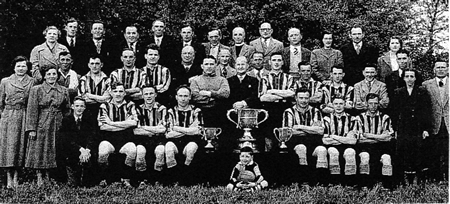 |
This is Sarn Rovers 1955 - 1956 proudly displaying the three trophies they secured that season. |
The season 1959/60 was described by the then Chairman Jack Carr "as one of their most dramatic ever". He had been a long standing servant of Sarn Rovers and became their Chairman in 1959. His statement reflected the fact that almost all of the established players left with the majority going to Malpas who had a fantastic season winning everything that they competed for. Sarn ended the season 12th with the unwelcome record of having let in 100 goals - the following season they finished in 11th place. In the season 1961/2 The Rovers ended the year in 7th place but the highlight was beating Malpas 5-0 in February 1962. During the season 1962/3 they finished mid-table but they reached the League Cup Final and lost 3-1 to St Martins who were riding high at the time.
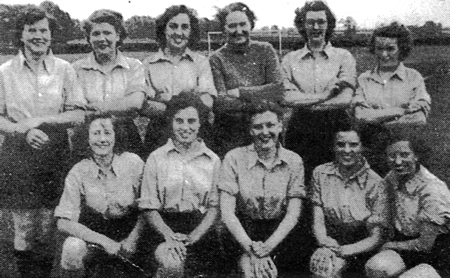 |
Sarn Rovers Ladies Team 1953 - 1954 |
In 1963/64 Reg Pickering returned to the side from Malpas and by the end of the season were in 6th place with Whixall as champions. This was repeated in the 1964/5. In 1965/66 they again finished 6th however, they beat St Martins in the semi-final of the League Cup but lost 4-0 to Wem in the final. In May 1967 Rovers finished 5th and again reached the League Cup Final but lost 5-1 to Whixall and the following season they finished 8th and were beaten in the semi-final of The Ethelston Cup by Beacon Youth Club. This was the closest that they would ever get to cup success again - they did however, finish 4th in the league in 1968/9.
In the 1950's the lady supporters who were not content with just watching formed their own ladies side and played friendlies against other local sides. These games appeared to attract good support and became an additional source of income and on one occasion at a game versus Waverton had over 400 fans/supporters watching.
In the early 60's Sarn Rovers were not only losing games but money too. Annual Dances, which were a vital source of revenue, floundered because bands were charging so much that the events became unprofitable. During the 1969/70 season, which saw Jack Carr resign as chairman, the number of clubs in the Whitchurch League dropped to 11. Jack Carr said that the Rovers had been very lucky to have had Mr Berry as their President, who along with other Vice-Presidents, had often provided financial support to keep the club going. However, it appeared that the writing was on the wall with fans now able to travel to bigger clubs and games on Saturdays which meant that were fewer young men that were willing or available to turn out for their local clubs. Consequently, 1971/2 was to be the last season for Sarn Rovers. They finished 10th from 12 in the league and their last game appears to have been versus Prees Amateurs which they lost 1-0. When the new season opened it did so without Sarn Rovers and The Whitchurch Herald reported that "The League will certainly be the poorer for the loss of such clubs as Sarn Rovers who were among the founder members of the competition when it started after the war". Eventually the league itself finished due to lack of interest and commitment - the few teams left joined other leagues.
This summary has been taken from a local book written by Neville Walker and kindly loaned to the History Group by John Bickley.
More on Sarn Rovers by Stephen Fowles
This contribution received in July 2025 adds more information regarding Sarn Rovers and included some fascinating photos of medals awarded in the early 1950's
My name is Stephen Fowles and I hailed from lscoyd. I played Cricket for lscoyd and Fenns Bank for 45 years and Football for Redbrook. The one person I know well (referred to above) is John Bickley. Regarding the section above on Sarn Rovers l was surfing the net intending to research the Goalkeeping career of my late uncle,Jack Fowles. I was always fully aware that he played for the Sarn and frequently checked out the 1952/53 team picture in the Queen's Head. On reading the Sarn Rovers section, I realized that I may have something of interest. When my Grandmother passed away, I was asked if I would like a keepsake. So I accepted Jack's football cup and medals. Amongst them I found two medals (see below) referred to in the article. I appreciate that you may be aware of these, however, there will be a very small number in circulation. They are not for sale under any circumstances. Uncle Jack was tragically killed ln a motorcycle accident, not long after I was born. As for the 1953 team, I knew - Frank Dimelow, Gordon Clutton, Doug Clorley, Reg Rickering,Derek Bell and Jack Parry.
 |
| click to enlarge |
SARN MILL by Dorothy Powell
Early mills were of wooden construction, repaired and updated as necessary. There is evidence of "a working corn mill" in 1699 - 1700 at Sarn and when Samuel Jones died in 1738 he was "miller at Sarn".
However at some point during the next 20 years there was a change of use, paper production began. In 1756 Worthenbury Parish Registers record the baptism in 1756 of a child of Thomas Jones of Sarn, a paper maker. Simon Hope, paper maker, and family arrived at Sarn Mill sometime before 1775 as that year his daughter Lydia married followed a few years later by his daughters Mabel & Ellen. His sons in law John Bleythin, another John Bleythin and Jonathan Hughes together with Richard and Thomas Hope, no doubt relations, were all paper makers.
Although the following newspaper reports do not name the owner it may have been H. Jones. Simon Hope, well established at Sarn, is not mentioned so was possibly only a tenant.
THE LONDON GAZETTE, Saturday 14th. December 1782
MAIL ROBBERY
Whereas the under mentioned Bills were in the Liverpool Bag that was stole out of the Mail at Fenny Stratford, on the night of the 8th.instant; Therefore this is the caution the Public at large not to give any Value upon said Bills, their Payment being stopped. It is moreover particularly requested, that in case any Person shall offer to negotiate any of them, that the Party may be stopped; and immediate Notice sent to the POST OFFICE, and Joseph Denison, and Co. of Jeffries Square, London.
Then followed a list of more than 70, lowest value £5-5-0 with highest value £500-0-0 including
Place and Date, Sarn Mill (Flintshire, Worthenbury Parish) 6th. Dec.
Drawer John Thomas,
Term 2 months
Order H. Jones
On whom drawn Jos. Denison &Co.
Sum £25 -0 –0.
THE LONDON GAZETTE, January 13, 1783
General Post –Office, December 11, 1782
The Bag of Letters from Liverpool and Wigan, of the 6th instant, which should have arrived at this Office on Monday Morning last, the 9th, having been stolen out of the mail-cart at the post-office in Fenny Stratford, in the Night of Sunday the 8th December: Whoever shall apprehend and convict, or cause to be apprehended and convicted, the Person or Persons who stole the said Bags, will be entitled to a Reward of FIFTY POUNDS.
By Command of the Post-Master General,
Anthony Todd, Secretary.
Simon Hope, Master Paper maker, in 1790 had an apprentice John Copnall and paid £5 apprentice duty. However there were soon to be many changes. Now about 67 years Simon had probably handed over the running of the papermaking. Jonathan Hughes and Thomas Hope who had become ’partners in paper making’ left Sarn Mill and as this report indicates the partnership was, on 1st. May 1793, mutually dissolved.
LONDON GAZETTE, Leek, November 13, 1793.
Notice is hereby given, that the Partnership lately subsisting between Jonathan Hughes, late of Sarn, in the Parish of Worthenbury in. the County of Flint, but now of Winkill Paper Mill, in the Parish of Waterfall in the County of Stafford, and Thomas Hope, late of Sarn aforesaid, but now of he Township of Heaton, in the Parish of Leek in the said County of Stafford, Paper-Makers, was mutually dissolved on the 1st Day of May last. The Business in future will be carried on by "them separately: And all Debts due to and owing from the said Co partnership are to be received and paid by the said, ' Jonathan Hughes’. Jonathan Hughes. Thomas Hope.
Richard Hope died in 1891, John Bleythin & Lydia moved to Staffordshire and John Bleythin, husband of Mabel, died in 1800. Between 1794 and 1812 the paper makers are William Pake, Thomas Becket, John Pake, William Blything and John Blything. Simon Hope died on 28th. March 1813 aged 83 in Tallarn Green and was buried at Worthenbury. He was late of Sarn Mill when he made his will on the 13th. July 1812.
On 31 December 1813 a notice in The Chester Chronicle states that B.Bates is the tenant of Sarn Mill and a Customs and Excise letter in 1816 states that Benjamin Bate was proprietor or master paper maker. A notice of Auction appeared in the Chester Courant ‘ the mill held by W Benjamin Bate (s) to be auctioned on 29 April 1819 at the Wynnstay Arms Wrexham. Bates continued to work the mill until the mid 1820’s. An sale advertisement in September 1826 ‘mill with the Drying and Rag House, croft and parcel of land ‘ states that it was late ‘late in the occupation of B. Bate’ the advertisement proceeds to claim that the stream of water &c. on which the mill is situate is worthy of a new mill, and is very valuable for the purpose of a Paper-Mill.’
From the evidence of a stone inscribed ’ Nathaniel Speakman built this mill 1827’ it would appear that he took notice of the claim in the advertisement, the old mill probably beyond repair. The 1840 Tithe Map shows that the mill, mill yard, meadow, mill house and gardens were still owned by Nathaniel Spakemam and occupied by Thomas Roberts.
With the opening of roller - mills large quantities of paper, made from wood, were produced ending the small-scale ‘rags paper ‘ industry.
Cheshire born Charles Burrows, having previously worked at Cefn y Bedd and Bersham paper mills, was on census day 1851 described as miller. Therefore it can be assumed that the paper making equipment had been removed and millstones installed.
From about 1859 George Powell was occupier and according to the 1861, he was a miller and farmer born in Prees. Within a few years he was ready to move on.
Whitchurch Herald 20 March 1869
Notice to Millers, Butchers, Farmers and The Public. At the Sarn Mill, Near Worthenbury, in the County of Flint, Mr. Cooper (auctioneer) has been honoured with instructions from Mr. Powell who is leaving the Mill and giving up business, to sell by auction on Mon March 29 1869 at 12 o’clock, his stock of 2 young short-horned Dairy Cows, as well as other assorted heifers, wagon horses, pigs, manure and de-pasturing of about 5 acres of Grass Land, potatoes etc. Also various wagons, carts and other sundries.
Next came Henry Done, miller and maltster, who in June 1878 was "showing" various parcels of land that were for sale, including the land he himself occupied. Very soon he left the mill.
In April 1881 Joseph Sumner, miller, previously of Bulkeley Mill was living at the mill with his wife Sarah, the only daughter of John Williams of Dymock’s Mill. By July 1882 he was leaving, quite likely for America as their age and place of birth fit a couple on a ship bound for New York. Henry Manley & Son were appointed to sell farm stock and furniture. Threapwood born James Woodhall and family arrived after July 1882, he was miller in 1885 and moved very soon after January 1890 and is enumerated on the 1891 census at Dymock’s Mill.
In February 1895 the Whitchurch Herald reported;
FIRE at SARN MILL.
At 2 o’clock on Thursday morning a fire, which eventually proved to be a most disastrous one, was discovered in the Saran Mill, about 3 ½ Miles from Maples, and owned and worked by Mr. Edward Broad of Streamwood, whose son was sleeping in the mill upon that night. We learn that the fire originated through some live coals falling out of the fire grate on to the mill floor in close proximity to some sacks, which caught fire, and before the discovery was made, the flames extended and got firm hold of the dry seasoned woodwork of the mill; and before Mr. Philip Broad, who looks after the mill, could obtain help, the place was gutted, the roof falling in within half an hour after the outbreak. The new portion of the mill in which, during the last summer, Mr. Broad had erected a steam boiler, was saved with great effort by the help assembled; but as it was considered to send for the Malpas Fire engine, and it being too great a distance for any other engine, none was sent for, and the fire consequently burnt itself out. The damage to the mill, including the large quantity of corn that it contained, is estimated at a little short of £2000, and as neither the mill nor its contents were insured, the loss falls heavily upon its owner.
The mill would have been built mainly of wood and maybe even the one built by Nathaniel Speakman. Nothing is known historically of the building of the new brick three storeyed mill that rose from the ashes. The stone commemorating Nathaniel’s mill was retrieved from the debris and incorporated in a wall.
Between 1901 and 1911 John Davies became the miller. He lived with his wife and children at the Mill House. John Davies, though born in Montgomeryshire, had lived in the area since early childhood. He was in charge until he retired in 1934, his sons John Thomas and George Capper, had worked with him, and then took over. John Thomas retired and died in 1974. George Capper Davies died in 1980.
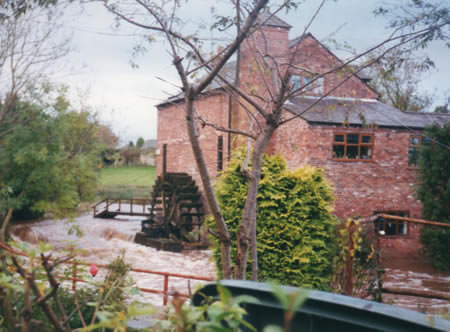 |
The mill was sold and subsequently converted into a house. The modern building is pictured here when the Wych Brook was in flood. |
September 2013.
Reported in the Whitchurch Herald and BBC1 Wales
SARN MILL WEIR
Salmon, sea trout and eel populations in the Wych Brook at Sarn Mill are to receive a boost as Natural Resources Wales starts work on a new scheme to open up the river.
Work has started to install a ‘rock ramp’ at Sarn Mill weir to help migratory fish pass over the weir and reach important spawning grounds further up the river.
The ‘ rock ramp’ will help to reduce the speed of river flows, making it easier for the fish to travel upstream and it will also help to reduce the flood risk to the Mill House.
No doubt many locals are unaware of the migratory fish in the brook. The late Mr. Joe Richardson (1904-2005) when interviewed by Neville Walker in 1996, said ‘he remembered, when a school boy, drinking water straight from the Wych Brook, the water being clear as crystal and that otters, eels and good-sized trout could be seen there.’

